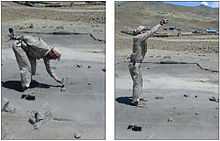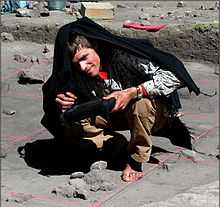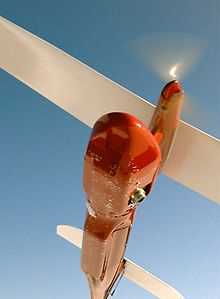Photomapping
Photomapping involves the process of drawing a map from a photographic base. "In all likelihood, computer map making, including analogue processing, will have replaced manual map making for well over 90 per cent of all maps".[1]
Principles and Definitions
Photomapping is the process of making a map with "cartographic enhancements"[2] that have been drawn from a photomosaic[3] that is "a composite photographic image of the ground" or more precisely as a controlled photomosaic where "individual photographs are rectified for tilt and brought to a common scale (at least at certain control points)."
Rectification of imagery is generally achieved by "fitting the projected images of each photograph to a set of four control points whose positions have been derived from an existing map or from ground measurements. When these rectified, scaled photographs are positioned on a grid of control points, a good correspondence can be achieved between them through skillful trimming and fitting and the use of the areas around the principal point where the relief displacements (which cannot be removed) are at a minimum."[2]
"It is quite reasonable to conclude that some form of photomap will become the standard general map of the future." [4] go on to suggest that, "photomapping would appear to be the only way to take reasonable advantage" of future data sources like high altitude aircraft and satellite imagery. The highest resolution aerial photomaps on GoogleEarth are approximately 2.5 cm spatial resolution images. The highest resolution photomap of ortho images was made in Hungary in 2012 with a 0.5 cm spatial resolution.
Photomapping in Archaeology


Demonstrating the link between orthophotomapping and archaeology,[5] historic airphotos photos were used to aid in developing a reconstruction of the Ventura mission that guided excavations of the structure's walls.

Overhead photography has been widely applied for mapping surface remains and excavation exposures at archaeological sites. Suggested platforms for capturing these photographs has included: War Balloons from World War I;[6] rubber meteorological balloons;[7] kites;[7][8] wooden platforms, metal frameworks, constructed over an excavation exposure;[7] ladders both alone and held together with poles or planks; three legged ladders; single and multi-section poles;[9][10] bipods;[11][12][13][14] tripods;[15] tetrapods[16][17] aerial bucket trucks ("cherry pickers"),[18] and light weight individuals dangling from the limb of a nearby tree.
Hand held near nadir over head digital photographs have been used with geographic information systems (GIS) to record excavation exposures.[19][20][21][22][23]
External links
Notes
- ↑ Robinson et al. (1977:16)
- ↑ 2.0 2.1 Petrie (1977: 50)
- ↑ Petrie (1977: 49)
- ↑ Robinson et al. (1977:10)
- ↑ Estes et al. (1977)
- ↑ Capper (1907)
- ↑ 7.0 7.1 7.2 Guy (1932)
- ↑ Bascom (1941)
- ↑ Schwartz (1964)
- ↑ Wiltshire (1967)
- ↑ Kriegler (1928)
- ↑ Hampl (1957)
- ↑ Whittlesey (1966)
- ↑ Fant and Loy (1972)
- ↑ Straffin (1971)
- ↑ Simpson and Cooke (1967)
- ↑ Hume (1969)
- ↑ Sterud and Pratt (1975)
- ↑ Craig (2000)
- ↑ Craig (2002)
- ↑ Craig and Aldenderfer (2003)
- ↑ Craig (2005)
- ↑ Craig et al. (2006)
References
- "Archaeological Photography", Antiquity 10, 1936: 486–490
- Bascom, W. R. (1941), "Possible Applications of Kite Photography to Archaeology and Ethnology", Illinois State Academy of Science, Transactions 34: 62–63
- Capper, J. E. (1907), "Photographs of Stonehenge as Seen from a War Balloon", Archaeologia 60: 571–572
- Craig, Nathan (2005), The Formation of Early Settled Villages and the Emergence of Leadership: A Test of Three Theoretical Models in the Rio Ilave, Lake Titicaca Basin, Southern Peru, Ph.D. Dissertation, University of California Santa Barbara, retrieved 9 February 2007
- Craig, Nathan (2002), "Recording Large-Scale Archaeological Excavations with GIS: Jiskairumoko--Near Peru's Lake Titicaca", ESRI ArcNews, Spring, retrieved 9 February 2007
- Craig, Nathan (2000), "Real Time GIS Construction and Digital Data Recording of the Jiskairumoko, Excavation Perú", Society for American Archaeology Buletin 18 (1), retrieved 9 February 2007
- Craig, Nathan; Adenderfer, Mark (2003), "Preliminary Stages in the Development of a Real-Time Digital Data Recording System for Archaeological Excavation Using ArcView GIS 3.1", Journal of GIS in Archaeology 1: 1–22, retrieved 9 February 2007
- Craig, N., Aldenderfer, M. & Moyes, H. (2006), "Multivariate Visualization and Analysis of Photomapped Artifact Scatters", Journal of Archaeological Science 33: 1617–1627
- Estes, J. E., Jensen, J. R. & Tinney, L. R. (1977), "The Use of Historical Photography for Mapping Archaeological Sites", Journal of Field Archaeology 4: 441–447
- Fant, J. E. & Loy, W. G. (1972), "Surveying and Mapping", in Eds, The Minnesota Messenia Expedition
- Guy, P. L. O. (1932), "Balloon Photography and Archaeological Excavation", Antiquity 6: 148–155
- Hampl, F. (1957), "Archäologische Feldphotographie", Archaeologia Austriaca 22: 54–64
- Hume, I. N. (1969), Historical Archaeology, New York
- Kriegler, K. (1929), "Über Photographische Aufnahmen Prähistorischer Gräber", Mittheliungen der Anthropologischen Gesellschaft in Wien 58: 113–116
- Petrie, G. (1977), "Orthophotomaps", Transactions of the Institute of British Geographers 2: 49–70
- Robinson, A. H., Morrison, J. L. & Meuehrcke, P. C. (1977), "Cartography 1950-2000", Transactions of the Institute of British Geographers 2: 3–18
- Schwartz, G. T. (1964), "Stereoscopic Views Taken with an Ordinary Single Camera--A New Technique for Archaeologists", Archaeometry: 36–42
- Simpson, D. D. A. & Booke, F. M. B. (1967), "Photogrammetric Planning at Grantully Perthshire", Antiquity 41: 220–221
- Straffin, D. (1971), "A Device for Vertical Archaeological Photography", Plains Anthropologist 16: 232–234
- Wiltshire, J. R. (1967), "A Pole for High Viewpoint Photography", Industrial Commercial Photography: 53–56